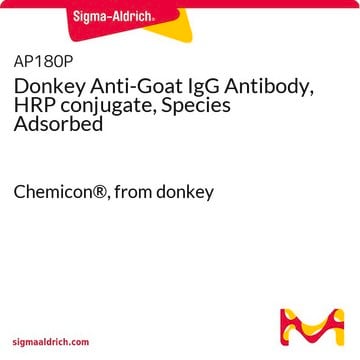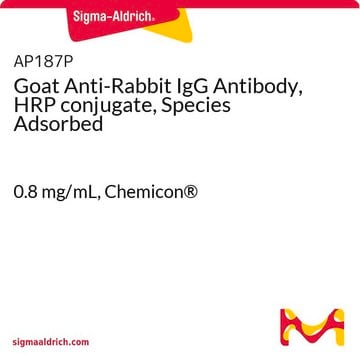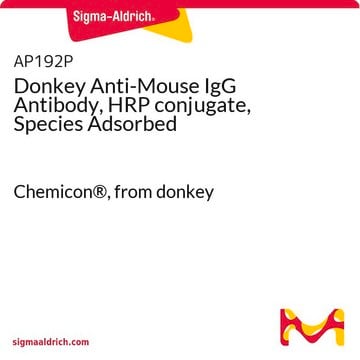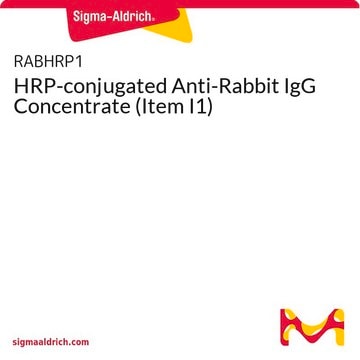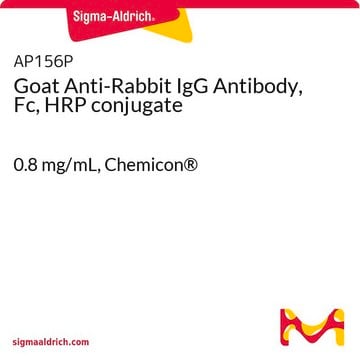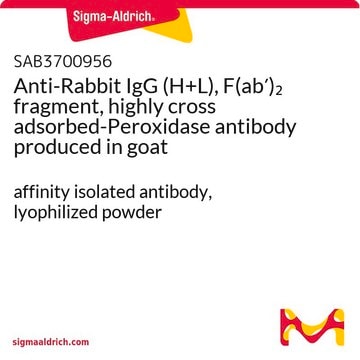AP182P
Donkey Anti-Rabbit IgG Antibody, HRP conjugate, Species Adsorbed
Chemicon®, from donkey
Synonym(s):
Anti-rabbit HRP antibody
Sign Into View Organizational & Contract Pricing
All Photos(1)
About This Item
UNSPSC Code:
12352203
eCl@ss:
32160702
NACRES:
NA.46
Recommended Products
biological source
donkey
Quality Level
conjugate
peroxidase conjugate
antibody form
affinity purified immunoglobulin
antibody product type
secondary antibodies
clone
polyclonal
species reactivity
rabbit
manufacturer/tradename
Chemicon®
technique(s)
ELISA: suitable
western blot: suitable
shipped in
wet ice
target post-translational modification
unmodified
General description
Immunoglobulin G (IgG), is one of the most abundant proteins in human serum with normal levels between 8-17 mg/mL in adult blood. IgG is important for our defence against microorganisms and the molecules are produced by B lymphocytes as a part of our adaptive immune response. The IgG molecule has two separate functions; to bind to the pathogen that elicited the response and to recruit other cells and molecules to destroy the antigen. The variability of the IgG pool is generated by somatic recombination and the number of specificities in an individual at a given time point is estimated to be 1011 variants.
Specificity
Rabbit IgG
Application
Donkey anti-Rabbit IgG Antibody, HRP conjugate, Species Adsorbed is an antibody against Donkey Rabbit IgG for use in ELISA & WB.
EIA and Western blots: 1:5,000-1:100,000.
Immunohistochemistry: 1:500-1:5,000.
Western blotting with ECL substrates: 1:10,000-1:200,000.
Optimal working dilutions must be determined by end user.
Immunohistochemistry: 1:500-1:5,000.
Western blotting with ECL substrates: 1:10,000-1:200,000.
Optimal working dilutions must be determined by end user.
Research Category
Secondary & Control Antibodies
Secondary & Control Antibodies
Research Sub Category
Secondary Antibodies Adsorbed for Dual Labeling
Secondary Antibodies Adsorbed for Dual Labeling
Physical form
Lyophilized. Buffer = 0.01 M Sodium Phosphate, 0.25 M NaCl, pH 7.6 with 15 mg/mL BSA. Contains no preservative.
RECONSTITUTION:
Reconstitute with 500 μL of sterile distilled water.
RECONSTITUTION:
Reconstitute with 500 μL of sterile distilled water.
Storage and Stability
Maintain lyophilized product at 2-8°C for up to 12 months. After reconstitution the product is stable for several weeks at 2-8°C as an undiluted liquid. For extended storage after reconstitution, add an equal volume of glycerol to make a final concentration of 50% glycerol followed by storage at -20°C in undiluted aliquots for up to 12 months. Please note the concentration of protein (and buffer salts) will decrease to one-half of the original after the addition of glycerol. Avoid repeated freeze/thaw cycles.
WARNING:
Use of sodium azide as a preservative will substantially inhibit the enzyme activity of HRP.
WARNING:
Use of sodium azide as a preservative will substantially inhibit the enzyme activity of HRP.
Other Notes
Concentration: Please refer to the Certificate of Analysis for the lot-specific concentration.
Legal Information
CHEMICON is a registered trademark of Merck KGaA, Darmstadt, Germany
Disclaimer
Unless otherwise stated in our catalog or other company documentation accompanying the product(s), our products are intended for research use only and are not to be used for any other purpose, which includes but is not limited to, unauthorized commercial uses, in vitro diagnostic uses, ex vivo or in vivo therapeutic uses or any type of consumption or application to humans or animals.
Not finding the right product?
Try our Product Selector Tool.
Storage Class Code
11 - Combustible Solids
WGK
WGK 3
Certificates of Analysis (COA)
Search for Certificates of Analysis (COA) by entering the products Lot/Batch Number. Lot and Batch Numbers can be found on a product’s label following the words ‘Lot’ or ‘Batch’.
Already Own This Product?
Find documentation for the products that you have recently purchased in the Document Library.
Customers Also Viewed
Xuejun Dai et al.
International journal of oncology, 54(1), 261-270 (2018-11-06)
Glioblastoma multiforme (GBM) has the highest mortality rate among patients with brain tumors, and radiotherapy forms an important part of its treatment. Thus, there is an urgent requirement to elucidate the mechanisms conferring GBM progression and radioresistance. In the present
Alexandre Crépin et al.
The Biochemical journal, 401(1), 49-55 (2006-09-13)
Prolactin (PRL) has been shown to be involved in the differentiation and proliferation of numerous tissues, including the prostate gland. Moreover, variations in [Ca2+]ER (calcium concentration within the endoplasmic reticulum) may play a role in cell growth. However, few studies
Natsumi Shimizu et al.
The Journal of reproduction and development, 60(3), 179-186 (2014-03-04)
In the mammalian testis, the ubiquitin-proteasome system plays important roles in the process that promotes the formation of mature sperm. We recently identified zygote-specific proteasome assembly chaperone (ZPAC), which is specifically expressed in the mouse gonads and zygote. ZPAC mediates
Michael L Reiser et al.
Scientific reports, 7(1), 736-736 (2017-04-09)
TOLL-like receptor (TLR) ligands activate both innate and adaptive immune cells, while modulating the cellular immune response. The outer membrane protein (OMP) from Neisseria meninigitidis, PorB, is a naturally occurring TLR2 ligand and functions as an adjuvant. Here, we demonstrate
Hiroaki Hiramatsu et al.
Scientific reports, 7(1), 889-889 (2017-04-20)
Glioma initiating cells (GICs) are thought to contribute to therapeutic resistance and tumor recurrence in glioblastoma, a lethal primary brain tumor in adults. Although the stem-like properties of GICs, such as self-renewal and tumorigenicity, are epigenetically regulated, the role of
Our team of scientists has experience in all areas of research including Life Science, Material Science, Chemical Synthesis, Chromatography, Analytical and many others.
Contact Technical Service